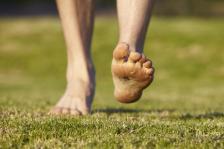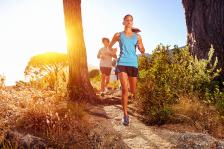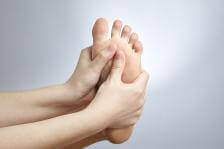5 Ways to Get Stronger Feet
The strength of your feet affects a lot of things—your ankles, hips, lower back, abs, posture, walking, and even the space in your chest where your lungs live. This week, Get-Fit Guy gives you 5 quick and practical tips on how you can get stronger feet.
Ben Greenfield
Listen
5 Ways to Get Stronger Feet

In the book, she outlines how conventional shoes can cause your feet to lose mobility and muscle, the importance of walking on natural and uneven surfaces, and the specific, corrective exercises that can safely and effectively allow you to transition shoe-adapted feet and legs to more natural, minimalist footwear.
And then, earlier this week, someone brought to my attention this article in the British Journal of Sports Medicine. It discusses one core that we need to be training, but that we often don’t think about—a core that goes beyond the traditional abdominal and low back core. You guessed it—the foot core!
So, although way back in Episode #91 I taught you how to start running barefoot, I thought it would be quite appropriate to expound even more on how to get strong feet. After all, the strength of your feet affects your ankles, hips, lower back, abs, posture, walking, and even the space in your chest where your lungs live!
The Problem with Most Shoes
Even though most shoes are engineered for things like performance, protection, limiting over-pronation, and of course, fashion, they don’t really take into account some very important health factors.
One such factor is the toe-box in a conventional shoe. The toe-box in shoes often presses your toes together, which can weaken foot muscles and affect nerve health.
Another problem with many conventional shoes is the thick soles with plenty of cushioning. While certainly comfortable, this can reduce input to sensory nerves in the feet, affecting your balance and your “feel” for the surfaces you’re walking on.
Elevated heels in most conventional shoes make it very difficult for your ankles to move through a proper range of motion. This places more stress on your hips, knees, and lower back (sorry ladies, but high heels are an especially big culprit when it comes to this problem).
Finally, built-up arches in shoes create an environment in which the support of the shoe is doing all the work instead of the natural arch muscles and ligaments in your feet. This means that if you ever decide to, say, go for a walk on the beach barefoot, play a sport that requires jumping and landing, or take up marathon running, your feet muscles and arches aren’t going to be prepared for those rigors, and you’re going to experience a lot of foot pain.
So here are 5 quick, practical things you can do, right now, to make your feet stronger:
Tip #1: Walk on Uneven Surfaces

For example, this morning I went for a run in a park that had a paved path around the entire 3 mile perimeter of the park. Rather than running on that path, I tried to run around the whole park without “touching” the pavement. Instead, I stuck to the gravel, grass, dirt, and the other undulating terrain on either side of the pavement.
Tip #2: Stretch Your Toes
Since your toes are getting constantly compressed inside the tight toe box of a shoe (and often have been for many years), you need to stretch the spaces between your toes. You can use your hands to stretch your toes away from each other by interlacing your fingers and toes together, or you can even buy toe spreaders or special toe spreader socks that do this job for you while you’re standing and sleeping.
Recently, I injured my heel in an obstacle race and had to wear built up, protective shoes for 2 months. Once I was out of those shoes, not only did I switch to minimalist shoes with a wide toe box, but I also spent a great deal of time barefoot and began sleeping each night with toe spreader socks to re-stretch my toes.
Tip #3: Strengthen Your Feet
There are oodles of ways to get stronger feet, but my favorite method is quite simple and straightforward.
Stand on one leg at every opportunity you get. This includes when you’re at your standing workstation (you are using one of those now, right?), brushing your teeth, cooking a meal, and even doing specific exercises at the gym, such as an overhead press.
Eventually, progress to standing on uneven surfaces on one leg, such as on a half-foam roller (it looks like this), a scrunched up towel, a pillow, or a dense foam mat that you can place next to a standing desk (here’s a video example of my own personal workstation).
Check out my episode How to Get Stronger Feet for more specific exercises for strengthening your feet.
Tip #4: Roll Your Feet
I keep a golf ball under my desk and I roll it around in circles under each foot at random intervals during the day. A small ball, like a golf ball, works much better than a foam roller, tennis ball, lacrosse ball, or other similar objects.
In a pinch, when I happen to be sitting for long periods of time, such as on an airplane or in a car, I’ll occasionally slip off my shoes and give myself a quick 5 minute foot massage. I knead the bottom of my feet, interlace my toes with my hand, and press up against the balls of my feet to stretch the calves. In other words, be your own foot masseuse!
Tip #5: Get Some Minimalist Shoes
Here are some websites where you can find information on minimalist footwear (yours truly uses both Vivobarefoot and Skoras for sports and casual, and Earthrunners for sandals):
Please be aware that minimalist shoes often fit a bit differently than conventional shoes, so be prepared to make some adjustments in your sizing. Also (as I discuss in my episode The 411 on Barefoot Running), make a slow gradual transition to minimalist footwear so that you don’t get muscular injuries or stress fractures.
Do you have more questions about how to get stronger feet or transition to minimalist footwear? Then head over to Facebook.com/GetFitGuy and join the conversation there!
Barefoot Running, Foot Massage, and Running Outdoors images courtesy of Shutterstock.


